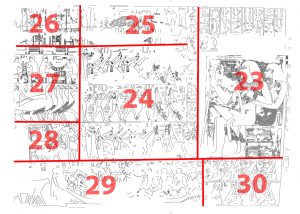
The wall contains scenes depicting Merefnebef enjoying amenities of life, which he hoped to continue for eternity.
To the right, the vizier – embraced by one of his wives (her name not preserved) – shelters from the sun in a gazebo (23) made of plaited reed mats; the couple watches dancing girls (24). There are three groups of dancers, each preceded by two harpists. Behind the dancers, standing women beat the rhythm clapping their hands and maybe singing as well. It is noteworthy, how skillfully an anonymous artist rendered the movement of the harpists’ fingers. In the lowermost register, a singer sits in front of the harpists, and the inscription above records his song: ”I tell a story of love, in everlasting words“. Above the scene with dancers, piles of food are stacked (25), prepared for a feast that is held – according to the inscription – in the villages of the vizier’s funerary estate.
Along the left end of the wall, everyday activities, taking place behind the scenes of the festivities, are depicted. In the uppermost register (26), two servants kneel on a bed, smoothing the mattress, upon which there is also a headrest. Below, in a jewellery workshop, four craftsmen are busy with making necklaces (27), and herdsmen drive geese (surprisingly large in size compared to humans, which indicates that they were considered more important than their carers) and cattle (28).
In the lowermost register, the scene on the left shows animals being transported by boats (29), while on the right and directly under the vizier’s gazebo, another group of musicians is depicted (30). Judging by the frequency of their depiction in the tomb, one may suppose that Merefnebef was a true music lover.
